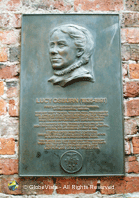Lucy Osburn plaque

Public Art: Lucy Osburn plaque
Artist: ©
Description: A simple bronze plaque featuring a relief portrait of Lucy Osburn
Date Unveiled: 11th of July, 1984 by Lady Rowland
Location: On the wall at Nurse’s Walk, George Street, The Rocks, Sydney, Australia.
Inscription :
LUCY OSBURN
Plaque commemorates the first lady superintendent of the Nursing Sydney Hospital.
Lucy Osburn arrived in 1868 accompanied by five trained nurses following the Sir Henry Parkes appeal to Florence Nightingale for trained nurses for the Sydney Infirmary. Lucy Osburn trained at St Thomas’ Hospital in London and also at the Kaiserwerth Hospital near Dusseldorf in Germany, which had greatly influenced Florence Nightingale’s ideas. She was identified as ‘an outstanding graduate’ at the Nightingale School and set sail for Australia following her appointment as Superintendent and Chief Female Officer of the Sydney Infirmary (later called the Sydney Hospital).
Together with five other Nightingale nurses, Ms Osburn arrived in Sydney in 1868, where she encountered appalling conditions and hostility from medical staff. She spent the next 12 years transforming the hospital and training nurses in the Nightingale tradition.
Miss Osburn left Sydney in 1884. She died on 22 December 1891.
Who was Lucy Osburn?: One of the most noted and formidable nurses to arrive in Sydney was Lucy Osburn and she is honoured with a plaque along Nurse’s Walk. Lucy was known for introducing Florence Nightingale’s principles of nursing to New South Wales.
Lucy Osburn was born in England on the 10th of May, 1835.
She later trained at St Thomas Hospital in London and also Kaiserwerth Hospital in Germany. She became a successful graduate of the Nightingale School but not all were happy with her choice of occupation. It is said that her father turned her portrait to the wall when she entered the Nightingale Training School.
Lucy and five other nursing sisters were sent by Florence Nightingale following an appeal by the then Premier of New South Wales, Henry Parkes. In March 1868 Lucy arrived in Sydney to take charge of an Infirmary. One of her first patients was to be the Duke of Edinburgh who was wounded after an assassination attempt at Clontarf.
The conditions of the infirmary were appalling. Not only was the hospital in poor working order, but the staff also had to contend with rats and vermin. The Rocks and surrounding areas were mostly slums. Gangs, known as The Push, roamed the poorly lit streets.
The road for Osburn in Sydney was not an easy one. She was ill-equipped to handle such a task. Having little co-operation from the male Superintendant or the House Committee she was left to handle all responsibilities. With an autocratic style of management and a less than friendly personality, it wasn’t surprising she had several scandals to contend with.
Religious tensions also arose when Lucy Osburn introduced instituted practices. Tensions between Roman Catholics and Protestants weren’t just rising between the gangs, it was also growing within the hospital. Osburn had introduced a hierarchical system of management in which she had total control of nursing and the nurses. Some believed that this was a way for her to secretly introduce Catholic practices into the hospital system.
Osburn’s system also had a class prejudice. Those entering from working-class backgrounds were expected to remain, nurses, and were unable to train to become Sisters or Matrons.
In 1870 she was accused of burning Bibles in which she was later vindicated by a Commission of Inquiry. Following this, Florence Nightingale accused her of having her own views and agenda beyond that of the Nightingale system.
Fortunately for Osburn, she had the backing of Sir Henry Parkes and other influential friends enabling her to dodge every bullet fired at her. She remained in charge until 1884 when ill health, due to diabetes, forced her to resign.
Controversy would continue to plague her. When she left Sydney she traveled extensively before returning to England. In 1886 she retrained as a nurse and was then appointed Superintendent, working in the slums of London’s East End. She made nice with Florence Nightingale for a short time before clashing with her over the battle for “state registration of nurses”. This would be her last hooray. In 1891 she resigned again due to ill health. Just before Christmas, she passed away.